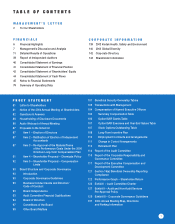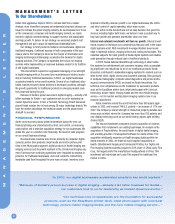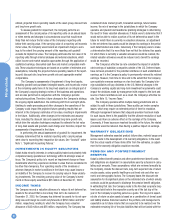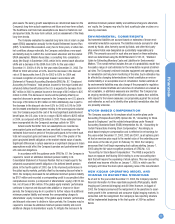Kodak 2003 Annual Report Download - page 9
Download and view the complete annual report
Please find page 9 of the 2003 Kodak annual report below. You can navigate through the pages in the report by either clicking on the pages listed below, or by using the keyword search tool below to find specific information within the annual report.
Financials
9
plan assets. The salary growth assumptions are determined based on the
Company’s long-term actual experience and future and near-term outlook.
The healthcare cost trend rate assumptions are based on historical cost
and payment data, the near-term outlook, and an assessment of the likely
long-term trends.
The Company evaluates its expected long-term rate of return on plan
asset (EROA) assumption annually for the Kodak Retirement Income Plan
(KRIP). To facilitate this evaluation, every two to three years, or when mar-
ket conditions change materially, the Company undertakes a new asset
and liability study to reaffirm the current asset allocation and the related
EROA assumption. Wilshire Associates, a consulting firm, completed a
study (the Study) in September 2002, which led to several asset allocation
shifts and a decrease in the EROA from 9.5% for the year ended
December 31, 2002 to 9.0% for the year ended December 31, 2003. The
EROA for 2004 will remain at 9.0%. Given the decrease in the discount
rate of 50 basis points from 6.5% for 2003 to 6.0% for 2004 and
increased recognition of unrecognized losses in accordance with
Statement of Financial Accounting Standards (SFAS) No. 87, “Employers’
Accounting for Pensions,” total pension income for the major funded and
unfunded defined benefit plans in the U.S. is expected to decrease from
$47 million in 2003 to pension income in the range of $15 million to $25
million in 2004. This decrease in income will be partially offset by an
expected decrease in pension expense in the Company’s non-U.S. plans in
the range of $5 million to $10 million in 2004. Additionally, due in part to
the decrease in the discount rate from 6.5% for 2003 to 6.0% for 2004
and increased amortization expense relating to the unrecognized actuarial
loss, the Company expects the cost of its most significant postretirement
benefit plan, the U.S. plan, to be in a range of $220 million to $265 million
in 2004, as compared with $229 million in 2003. These estimates have
been incorporated into the Company’s earnings outlook for 2004.
Actual results that differ from our assumptions are recorded as
unrecognized gains and losses and are amortized to earnings over the
estimated future service period of the plan participants to the extent such
total net recognized gains and losses exceed 10% of the greater of the
plan’s projected benefit obligation or the market-related value of assets.
Significant differences in actual experience or significant changes in future
assumptions would affect the Company’s pension and postretirement ben-
efit costs and obligations.
In accordance with the guidance under SFAS No. 87, the Company is
required to record an additional minimum pension liability in its
Consolidated Statement of Financial Position that is at least equal to the
unfunded accumulated benefit obligation of its defined benefit pension
plans. In the fourth quarter of 2003, due to the improved performance in
the global equity markets, partially offset by decreasing discount rates in
2003, the Company decreased its net additional minimum pension liability
by $167 million and recorded a corresponding credit to accumulated other
comprehensive income (a component of shareholders’ equity) of $122 mil-
lion, net of taxes of $45 million. If the global equity markets’ performance
continues to improve and discount rates stabilize or improve in future
periods, the Company may be in a position to further reduce its additional
minimum pension liability and reverse the corresponding charges to
shareholders’ equity. Conversely, if the global equity markets’ performance
and discount rates were to decline in future periods, the Company may be
required to increase its additional minimum pension liability and record
additional charges to shareholders’ equity. To mitigate the increase in its
additional minimum pension liability and additional charges to sharehold-
ers’ equity, the Company may elect to fund a particular plan or plans on a
case-by-case basis.
ENVIRONMENTAL COMMITMENTS
Environmental liabilities are accrued based on estimates of known envi-
ronmental remediation exposures. The liabilities include accruals for sites
owned by Kodak, sites formerly owned by Kodak, and other third party
sites where Kodak was designated as a potentially responsible party
(PRP). The amounts accrued for such sites are based on these estimates,
which are determined using the ASTM Standard E 2137-01, “Standard
Guide for Estimating Monetary Costs and Liabilities for Environmental
Matters.” The overall method includes the use of a probabilistic model that
forecasts a range of cost estimates for the remediation required at individ-
ual sites. The Company’s estimate includes equipment and operating costs
for remediation and long-term monitoring of the sites. Such estimates may
be affected by changing determinations of what constitutes an environ-
mental liability or an acceptable level of remediation. Kodak’s estimate of
its environmental liabilities may also change if the proposals to regulatory
agencies for desired methods and outcomes of remediation are viewed as
not acceptable, or additional exposures are identified. The Company has
an ongoing monitoring and identification process to assess how activities,
with respect to the known exposures, are progressing against the accrued
cost estimates, as well as to identify other potential remediation sites that
are presently unknown.
STOCK-BASED COMPENSATION
The Company accounts for its employee stock incentive plans under
Accounting Principles Board (APB) Opinion No. 25, “Accounting for Stock
Issued to Employees” and the related interpretations under Financial
Accounting Standards Board (FASB) Interpretation No. 44, “Accounting for
Certain Transactions Involving Stock Compensation.” Accordingly, no
stock-based employee compensation cost is reflected in net earnings for
the years ended December 31, 2003, 2002 and 2001, as all options grant-
ed had an exercise price equal to the market value of the underlying com-
mon stock on the date of grant. On February 18, 2004, the Company
announced that it will begin expensing stock options starting January 1,
2005 using the fair value recognition provisions of SFAS No. 123,
“Accounting for Stock-Based Compensation.” The FASB is expected to
issue an exposure draft during 2004 relating to a new accounting stan-
dard that will require the expensing of stock options. This new accounting
standard may become effective on January 1, 2005, in which case the
Company will follow the stock option expensing rules of the new standard.
NEW KODAK OPERATING MODEL AND
CHANGE IN REPORTING STRUCTURE
As of and for the year ended December 31, 2003, the Company reported
financial information for three reportable segments (Photography, Health
Imaging and Commercial Imaging) and All Other. However, in August of
2003, the Company announced the realignment of its operations to accel-
erate growth in the commercial and consumer digital imaging markets. In
connection with the realignment, the Company’s new reporting structure
will be implemented beginning in the first quarter of 2004 as outlined
below:






















